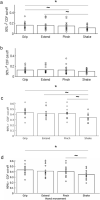Spontaneous activity patterns in human motor cortex replay evoked activity patterns for hand movements
- PMID: 36207360
- PMCID: PMC9546868
- DOI: 10.1038/s41598-022-20866-5
Spontaneous activity patterns in human motor cortex replay evoked activity patterns for hand movements
Abstract
Spontaneous brain activity, measured with resting state fMRI (R-fMRI), is correlated among regions that are co-activated by behavioral tasks. It is unclear, however, whether spatial patterns of spontaneous activity within a cortical region correspond to spatial patterns of activity evoked by specific stimuli, actions, or mental states. The current study investigated the hypothesis that spontaneous activity in motor cortex represents motor patterns commonly occurring in daily life. To test this hypothesis 15 healthy participants were scanned while performing four different hand movements. Three movements (Grip, Extend, Pinch) were ecological involving grip and grasp hand movements; one control movement involving the rotation of the wrist was not ecological and infrequent (Shake). They were also scanned at rest before and after the execution of the motor tasks (resting-state scans). Using the task data, we identified movement-specific patterns in the primary motor cortex. These task-defined patterns were compared to resting-state patterns in the same motor region. We also performed a control analysis within the primary visual cortex. We found that spontaneous activity patterns in the primary motor cortex were more like task patterns for ecological than control movements. In contrast, there was no difference between ecological and control hand movements in the primary visual area. These findings provide evidence that spontaneous activity in human motor cortex forms fine-scale, patterned representations associated with behaviors that frequently occur in daily life.
© 2022. The Author(s).
Conflict of interest statement
The authors declare no competing interests.
Figures






Similar articles
-
A visual representation of the hand in the resting somatomotor regions of the human brain.Sci Rep. 2024 Aug 7;14(1):18298. doi: 10.1038/s41598-024-69248-z. Sci Rep. 2024. PMID: 39112629 Free PMC article.
-
Spontaneous Activity Patterns in Human Attention Networks Code for Hand Movements.J Neurosci. 2023 Mar 15;43(11):1976-1986. doi: 10.1523/JNEUROSCI.1601-22.2023. Epub 2023 Feb 14. J Neurosci. 2023. PMID: 36788030 Free PMC article.
-
Brain-wide dynamic coactivation states code for hand movements in the resting state.Proc Natl Acad Sci U S A. 2025 Mar 18;122(11):e2415508122. doi: 10.1073/pnas.2415508122. Epub 2025 Mar 12. Proc Natl Acad Sci U S A. 2025. PMID: 40073058
-
The Myelin Content of the Human Precentral Hand Knob Reflects Interindividual Differences in Manual Motor Control at the Physiological and Behavioral Level.J Neurosci. 2021 Apr 7;41(14):3163-3179. doi: 10.1523/JNEUROSCI.0390-20.2021. Epub 2021 Mar 2. J Neurosci. 2021. PMID: 33653698 Free PMC article.
-
Intracerebral ERD/ERS in voluntary movement and in cognitive visuomotor task.Prog Brain Res. 2006;159:311-30. doi: 10.1016/S0079-6123(06)59021-1. Prog Brain Res. 2006. PMID: 17071240
Cited by
-
Object-oriented hand dexterity and grasping abilities, from the animal quarters to the neurosurgical OR: a systematic review of the underlying neural correlates in non-human, human primate and recent findings in awake brain surgery.Front Integr Neurosci. 2024 Feb 15;18:1324581. doi: 10.3389/fnint.2024.1324581. eCollection 2024. Front Integr Neurosci. 2024. PMID: 38425673 Free PMC article.
-
Different MRI structural processing methods do not impact functional connectivity computation.Sci Rep. 2023 May 26;13(1):8589. doi: 10.1038/s41598-023-34645-3. Sci Rep. 2023. PMID: 37237072 Free PMC article.
-
Time-dependent consolidation mechanisms of durable memory in spaced learning.Commun Biol. 2025 Apr 1;8(1):535. doi: 10.1038/s42003-025-07964-6. Commun Biol. 2025. PMID: 40169798 Free PMC article.
-
Free Will as Defined by the Constrained Disorder Principle: a Restricted, Mandatory, Personalized, Regulated Process for Decision-Making.Integr Psychol Behav Sci. 2024 Dec;58(4):1843-1875. doi: 10.1007/s12124-024-09853-9. Epub 2024 Jun 20. Integr Psychol Behav Sci. 2024. PMID: 38900370 Free PMC article. Review.
-
A visual representation of the hand in the resting somatomotor regions of the human brain.Sci Rep. 2024 Aug 7;14(1):18298. doi: 10.1038/s41598-024-69248-z. Sci Rep. 2024. PMID: 39112629 Free PMC article.
References
Publication types
MeSH terms
LinkOut - more resources
Full Text Sources

